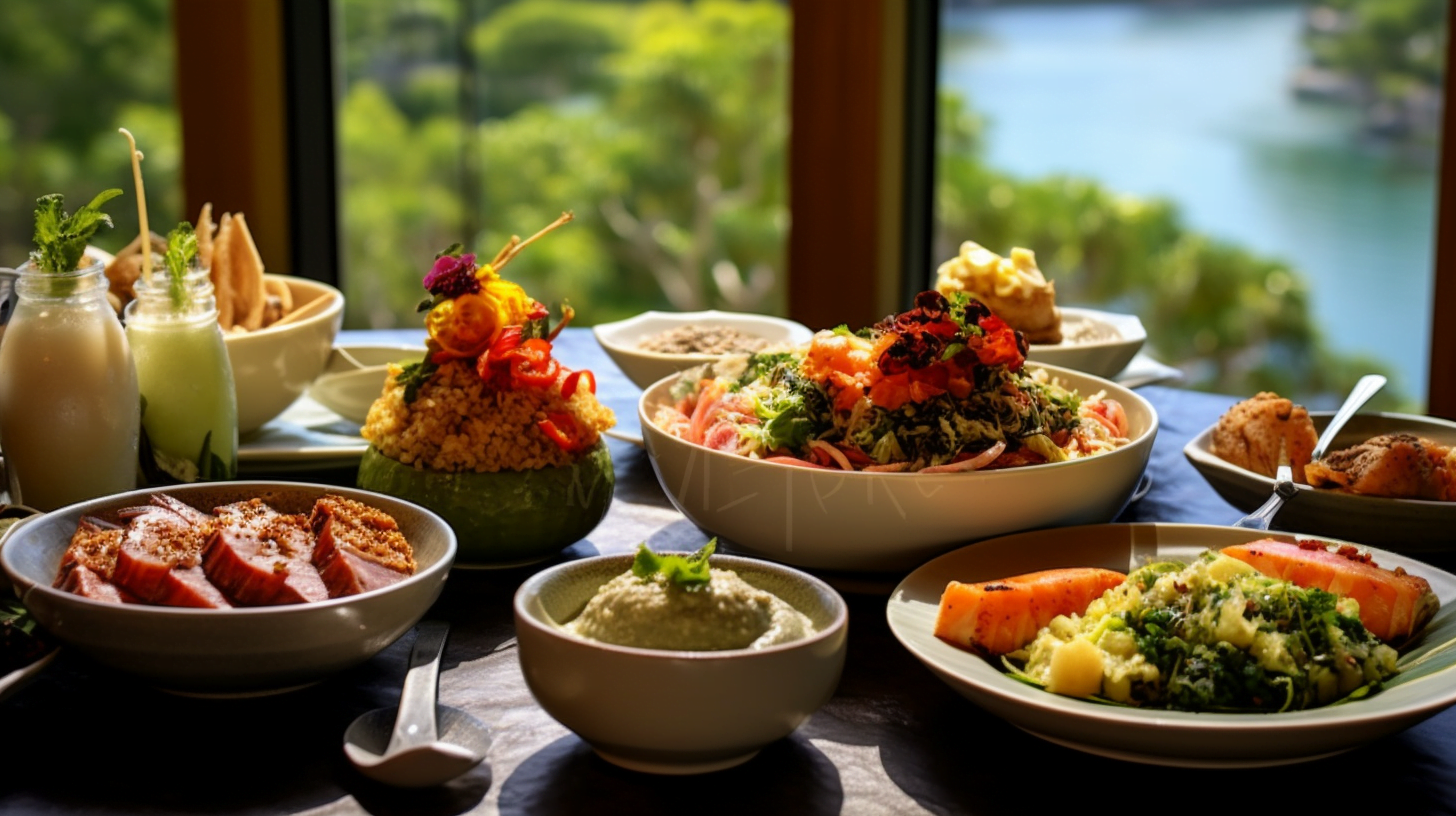Taste the Multicultural Flavors of Oahu 🏝️
As you step onto the sandy shores of Oahu, the gentle breeze carries with it the tantalizing scent of the island’s cuisine. Oahu, known for its diverse cultural influences, boasts an array of dishes that will leave your taste buds dancing.
The cuisine of Oahu is a reflection of the island’s rich history and cultural diversity. The traditional Hawaiian dishes are deeply rooted in the island’s history and are a celebration of the land and sea. Japanese, Chinese, Filipino, and Portuguese influences have also played a significant role in shaping the island’s culinary landscape. The result is a delicious fusion of flavors and techniques that will leave you wanting more.
In this article, we will explore the unique and diverse cuisine of Oahu and discover what makes it so special.
Key Takeaways
- Oahu cuisine is heavily influenced by the island’s diverse cultural heritage, including traditional Hawaiian, Japanese, Chinese, Filipino, and Portuguese influences.
- Modern fusion cuisine in Oahu blends traditional Hawaiian ingredients with Asian and European flavors, with chefs experimenting with innovative flavor combinations and fusion techniques.
- Popular fusion dishes in Oahu include poke bowls with Korean-inspired sauces, sushi rolls with tropical fruits, and Hawaiian-style pizza with Portuguese sausage and pineapple.
- Oahu’s chefs showcase their creativity and passion for food through the use of fusion techniques and ingredients, making the culinary scene in Oahu worth exploring for food lovers.
Traditional Hawaiian Dishes
Let’s talk about some of the traditional Hawaiian dishes that are still popular today and have been enjoyed for centuries. Hawaiian food culture is deeply rooted in the use of local ingredients and flavors, and these traditional dishes are no exception.
Poi, for example, is made from pounded taro, a starchy root vegetable that has been cultivated in Hawaii for generations. The process of making poi involves steaming the taro, then pounding it into a smooth, creamy consistency. It has a slightly sour taste and is often eaten with other dishes, such as kalua pork or lomi salmon.
Another popular traditional Hawaiian dish is laulau, which is made by wrapping meat, usually pork, in taro leaves and then steaming it for several hours. The leaves impart a unique flavor to the meat, and the slow, gentle cooking process results in tender, juicy meat that falls off the bone. Laulau is often served with rice and a side of poi.
These traditional Hawaiian dishes are a testament to the rich culinary history of Hawaii, and they continue to be enjoyed by locals and visitors alike. Moving on to the subsequent section about Japanese influences, you might be surprised to learn that Hawaii’s culinary traditions are also heavily influenced by Japanese cuisine.
Japanese Influences
You’ll notice the strong Japanese influence in many of the dishes you’ll find in local restaurants on the island. From sushi variations to ramen adaptations, these dishes have been tailored to suit the local palate.
Here are four examples of the Japanese influence on Oahu’s cuisine:
- Poke bowls – a popular Hawaiian dish made with raw fish, is heavily influenced by Japanese sashimi.
- Musubi – a snack made of rice and various toppings wrapped in seaweed, is a Hawaiian take on the Japanese onigiri.
- Ramen – a Japanese noodle soup dish, has been adapted to include local ingredients such as Spam or kimchi.
- Tempura – a Japanese dish of battered and fried seafood or vegetables, is a staple in many Oahu restaurants.
As you venture into the next section about ‘Chinese influences’, you’ll see how the blend of Japanese and Chinese flavors has brought about a unique culinary experience on the island.
Chinese Influences
One cannot deny the significant influence of Chinese cuisine on the island, with dishes such as char siu pork and dim sum being popular among locals and tourists alike, like a dragon breathing fire into the already diverse culinary scene of Hawaii. Dim sum delights, in particular, have become a staple among Oahu’s Chinese community, with various restaurants and food trucks offering a wide array of dumplings, bao buns, and other small dishes. Whether steamed or fried, sweet or savory, these bite-sized treats are perfect for sharing and have become a favorite among many food enthusiasts.
Another Chinese dish that has evolved on the island is chop suey. Originally created in the United States during the late 19th century, chop suey has been adapted to fit the local tastes and ingredients of Hawaii. Oahu’s version of chop suey often features a mix of vegetables, meats, and sauces, served over a bed of rice or noodles. While it may not be traditional Chinese cuisine, chop suey has become a beloved comfort food on the island. As Chinese influences continue to shape the culinary landscape of Oahu, it is fascinating to see how these dishes have evolved over time.
Moving on to the next subtopic, Filipino influences have also played a significant role in Oahu’s cuisine.
Filipino Influences
Filipino cuisine has left a lasting impression on Hawaiian taste buds, making mouths water with its bold and flavorful dishes. The influence of Filipino cuisine on modern Hawaiian dishes can be seen in the use of ingredients like adobo, pork belly, and lumpia. The fusion of Filipino flavors with other cuisines has resulted in dishes like adobo fried rice, pork belly bao buns, and lumpia tacos.
One of the most popular Filipino dishes in Hawaii is chicken adobo. The combination of soy sauce, vinegar, garlic, and bay leaves creates a savory and tangy flavor that is irresistible. Adobo fried rice is a modern twist on this classic dish, incorporating the flavors of adobo into a fried rice dish.
The use of pork belly in Hawaiian cuisine is also a nod to Filipino influence, as pork belly is a staple in many Filipino dishes. Lumpia, or Filipino spring rolls, can also be found on many menus in Hawaii, sometimes with a fusion twist like lumpia tacos or lumpia nachos.
As Filipino cuisine has become a staple in Hawaiian cuisine, it has also paved the way for other cultures to influence Hawaiian cuisine. One such influence is Portuguese cuisine, which has played a significant role in shaping Hawaiian food culture.
Portuguese Influences
Portuguese influences on Hawaiian cuisine can be seen in the widespread popularity of malasadas, a Portuguese pastry that has become a beloved treat in Hawaii. These sweet, fried doughnuts are usually coated in sugar and are commonly served for breakfast or as a dessert. In fact, during the annual Malasada Festival, over 350,000 malasadas are sold, showcasing just how much Hawaiians love this Portuguese-inspired pastry.
Another popular Portuguese dish that has made its way into Hawaiian cuisine is Portuguese sausage. This spicy sausage is often found in local breakfast dishes and is used as a topping for pizzas and hot dogs. Its popularity has even led to the creation of a unique Hawaiian dish called loco moco, which consists of rice, a hamburger patty, a fried egg, and gravy, with Portuguese sausage sometimes added as an extra topping. The fusion of these two cuisines has resulted in a unique flavor profile that is distinctly Hawaiian.
As the culinary scene in Hawaii evolves, traditional dishes like malasadas and Portuguese sausage continue to be staples while also being incorporated into modern fusion cuisine.
Modern Fusion Cuisine
Now that you’ve got a taste of the Portuguese influences in Oahu’s cuisine, let’s explore the island’s modern fusion cuisine.
The food scene in Oahu has evolved over the years, and chefs are now experimenting with innovative flavor combinations, fusion techniques, and ingredients to create unique dishes that cater to diverse palates.
The fusion cuisine in Oahu is a reflection of the island’s diverse cultural heritage and the availability of fresh local produce.
Chefs are blending traditional Hawaiian ingredients with Asian and European flavors to create a new culinary experience.
Some of the popular fusion dishes include poke bowls with Korean-inspired sauces, sushi rolls with tropical fruits, and Hawaiian-style pizza with Portuguese sausage and pineapple.
The fusion techniques and ingredients used by Oahu’s chefs are a testament to their creativity and passion for food.
If you’re a food lover, Oahu’s modern fusion cuisine is definitely worth exploring.
Frequently Asked Questions
What are some popular vegetarian or vegan options in Oahu cuisine?
If you’re searching for the best vegetarian/vegan restaurants in Oahu, you’ll find plenty of delicious options. Top plant-based dishes in Oahu cuisine include poke bowls, tofu stir-fry, and veggie burgers.
Are there any traditional dishes that are only served during certain festivals or special occasions?
You’re in for a treat during traditional festivals! Hawaii’s food culture is deeply rooted in tradition, and many dishes hold cultural significance. Look out for the likes of laulau, kalua pig, and poi, served only during these special occasions.
How have Oahu chefs adapted traditional dishes to suit modern tastes?
Chefs in Oahu have adapted traditional dishes to suit modern tastes by creating fusion cuisine and incorporating local ingredients. These adaptations have resulted in unique and flavorful dishes that showcase the diverse culinary culture of the island.
What are some lesser-known Oahu dishes that are worth trying?
Discover the top hidden gems of Oahu’s culinary scene with fusion cuisine. From the savory flavors of okonomiyaki to the sweet and tangy taste of haupia, these lesser-known dishes are worth trying for a delicious and unique experience.
Are there any unique ingredients used in Oahu cuisine that are difficult to find outside of Hawaii?
You’ll find unique ingredients in Hawaiian food fusion that are hard to find outside of Hawaii. Some ingredient substitutions are made due to availability, but local favorites like taro, opihi, and lilikoi are a must-try.







